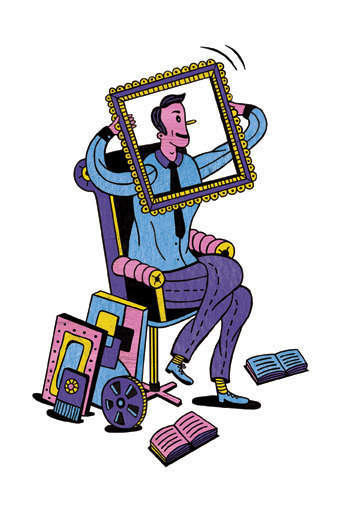
No Thanks, Just Looking You might think you know your art from your elbow while idly strolling through a gallery. Funny, though, how your critical faculties desert you as soon as you’re a buyer, says Sam Leith

No Thanks, Just Looking
You might think you know your art from your elbow while idly strolling through a gallery. Funny, though, how your critical faculties desert you as soon as you’re a buyer, says Sam Leith
It’s almost that time of year again, isn’t it? All those awful people, circulating around with their haircuts and their glasses of acidic fizzy plonk, looking at each other in rooms full of art. It’s art-fair time. To those as likes a painting, a sculpture, a collage, a room full of nothing or a room full of nobodies, this is a season of delight. And to those as can afford to buy any of the aforementioned, it’s a redoubled delight; a serious delight.
These are the ones you see walking through those rooms not so much air-kissing and checking out the eccentric glasses and skinny jeans of the hipsters but, rather, looking quite unabashedly at the actual art. You can almost see the throb of the black Amex in the back pocket. (I say that as a figure of speech: actually not only have I never seen a real black Amex, I don’t think I’ve ever knowingly come across an establishment at which Amex of any sort is accepted.)
Day two, day three, and the red dots have proliferated like an epidemic of architectural measles. I can no more afford to buy serious art, I regret to say, than I would be able to afford to insure it: even if someone gave me an itty-bitty Sarah Lucas it would end up living in a double-padlocked container at the Big Yellow Storage on the North Circular. So I’m as it were a bystander. And for me red dot time is where the fairs get really interesting. Where does the measles strike? Who’s buying? And how much?
This is great fun. It’s not too much to consider it as almost an art event in itself: the performative pleasure that the extremely wealthy and well-advised connoisseur gives to the civilian by allowing his acquisitions to be gazetted in real time. The pleasure and instruction we can take in marvelling at what gets bought and sold! The action of money on the art is enlivening.
Unlike a curated exhibition at, for instance, one of the Tates, the Saatchi Gallery or the RA — where nothing’s for sale, you know everything’s supposed to be good and your only response is to stroke your chin or inwardly shake your head — you’re seeing the tentative formation of a canon in real time.
These are people putting their own money down on their taste; or, for investors, placing bets on the market; or, in most cases, both. And the market is itself sort of fascinating — influenced as it is partly by movements in taste, partly by blatant insider trading, partly by guessing which way the herd goes and betting on that.

SO YOU MIGHT think that the one art fair at which I can plausibly expect to be able to buy art is the one that I would enjoy the most. That fair, of course, is the Affordable Art Fair — and I hope that mention of its name alone isn’t enough to get me expelled from the pages of a magazine aimed squarely at those for whom the word ‘affordable’ could be construed as either redundant or insulting.
But look, here’s the thing. I go along to it — last year I went with my now wife hellbent on buying us Our First Piece Of Art Together — and I find myself racked with anxiety. I can cope with art that’s not for sale. I positively delight in art that I can’t in a million years afford. But when confronted by art with which I plausibly could walk home, my mouth dries and my hands start to tremble.
Every bland and reassuring aesthetic certainty I have flies from me. I search my soul and find I have no idea whether any given piece is beautiful and clever or banal and stupid, twee or cute, naive or just inept. It’s like choosing paint for the living room in Farrow & Ball, except each tin costs a grand.
Is this how Dasha Zhukova feels at a White Cube show? Is this how a Saatchi feels at Sotheby’s? I can’t think so. But it makes me realise that I am such a one as will always get more pleasure out of watching poker on TV than playing it with more than £20 at stake.
It is for that reason that I all the more salute those who do buy art. Yes, even those buying Damien Hirst, infra-dig though he now is — in fact, I salute them especially, as they ride bravely skywards on what more and more are now saying is the biggest bubble since Facebook. Only their preparedness to do so gives us that trail of red dots to cogitate on, and brings the art fairs around which we mortals tramp into thrilling relief. I’d like to imagine they’d derive similar pleasure and instruction from watching me go round the Affordable Art Fair, but I suppose they would not.
Don’t miss out on the best of Spear’s articles – sign up to the Spear’s weekly newsletter
[related_companies]





